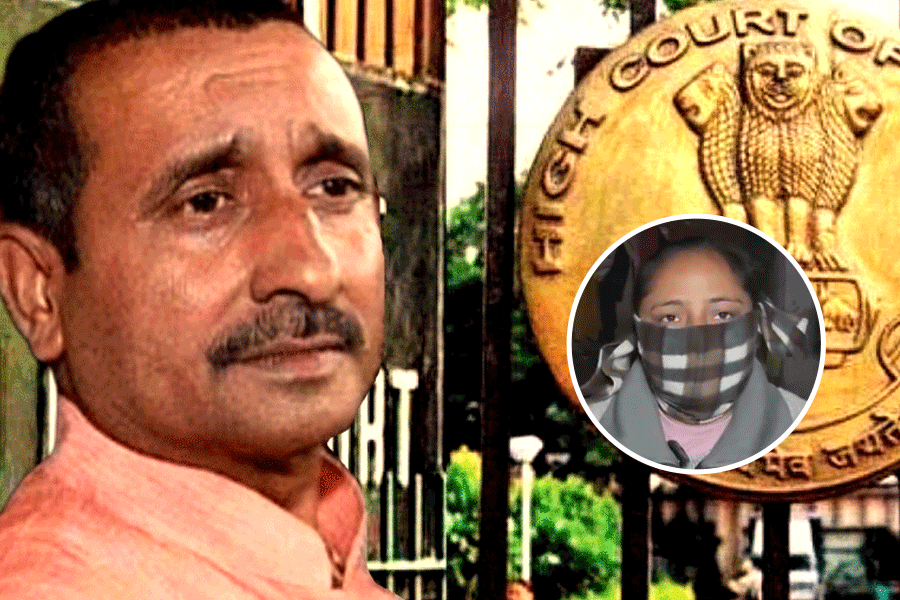 |
| 1989: The rescue capsule, with a miner inside, is pulled up at Mahabir Colliery, Ranigunj |
Mahabir Colliery (Ranigunj), Oct. 18: A coal pit accident leaves 64 miners trapped hundreds of feet underground and inches from a watery grave, and a poor nation swings into action.
Six holes are drilled and walkie-talkie sets lowered along with food and water. A rescue capsule is forged out of steel and iron while anxious families gather round the site. The story has a happy ending.
The human drama happened not in Chile this week but 21 years ago in Bengal’s Ranigunj. With no Nasa around to help build a space-age rescue vehicle, metal sheets were beaten into a shell-like capsule and the miners were hauled to safety one by one with a makeshift pulley, much like water is drawn from a well.
The rescue, which took place away from the world’s glare unlike Chile 2010, bore the stamp of a nation still miles away from eight per cent growth rates or any talk of being an emerging power.
 |
| 1989: Then chief minister Jyoti Basu arrives at the Eastern Coalfields hospital in Bansra near Ranigunj to visit the rescued miners |
It helped that the miners were trapped 380 feet below the clay-and-sandstone soil rather than under 2,050 feet of volcanic rock as in Chile, and that the crisis lasted four days, not 69.
Yet, immediately after water had rushed into the Mahabir Colliery of Eastern Coalfield Limited (ECL) in November 1989, many had feared a repeat of India’s worst-ever mine disaster. That had happened in 1975, when some 370 miners drowned in a pit in Chasnala near Dhanbad.
In the Ranigunj colliery, six miners drowned instantly, 64 jumped into cavities and crevices just beyond the water’s reach, and one virtually rescued himself by wading chest-deep water in the dark for 36 hours.
That man, Deokali Pandey, now 75, shuddered yesterday morning as son Bamdeo read out aloud from a Hindi newspaper, describing the Chile rescue. Memories were flooding into his mind.
 |
| 2010: Survivor Deokali Pandey, 75, at the site of the now-abandoned Mahabir Colliery. (Pictures by Gour Sharma, taken in November 1989 and October 2010) |
“I’ll never forget how close I came to death that night,” he said sitting in his stationery store near the now-abandoned Mahabir Colliery.
On November 13, 1989, Pandey had been one of the 220 miners on the night shift who had gone down the shaft around 10pm. Perhaps because of his experience, he had sniffed danger earlier than the others.
“It was around 4am. We were moving forward along the tunnel and breaking the coal walls by triggering blasts when I suddenly felt a cold draught hit my face,” Pandey said.
“I immediately realised that one of the blasts had cracked a wall adjacent to the underground water table. I turned around and shouted ‘Bhago, bhago, pani a raha hai (run for your lives, water will gush in any moment)’.”
Pandey turned round and ran towards the lift, nearly 1,800 feet away. “A torrent of water hit me and as I fell, I saw six of my colleagues being swept past me. I was carried forward on the crest and would probably have dashed my head against the mine wall had my left foot not got caught in the trolley tracks,” he recalled.
“The lights provided by an electric cable went off. Water was gushing over me. I somehow managed to grip an overhead electric cable and hung on for dear life.”
The water had climbed up to Pandey’s waist and he shivered. “I shook my foot free from the shoe that was caught in the tracks and firmly gripped the cable. I knew how to swim but it was so cold inside the tunnel that my body was becoming numb,” he said.
“I inched forward holding the cable. It took me nearly 36 hours to reach the lift, which was almost submerged. I somehow clambered onto the lift’s roof, pressed the switch for the emergency bell and passed out.”
Thankfully, the lift was still working and the man operating it over-ground raised it to safety, with an unconscious Pandey perched on its roof. He was rushed to the ECL hospital at nearby Bansra with a forehead injury and cuts and wounds all over him.
Of the 220 miners, 149 who were working near the lift had been hauled up right away as water began flooding the tunnel. Of the 71 working further ahead, six were dead and Pandey had been rescued. The remaining 64 were trapped at six locations underground.
Outside the mine, at least 1,000 people had gathered, among them the miners’ family members.
Nabakumar Mishra, the then ECL surveyor who took part in the four-day rescue operation, said six 380ft-deep holes, each two feet wide, were bored.
“We drilled the holes using the mine map. We sent walkie-talkie sets down at the end of a rope and spoke to the miners. We assured them of rescue. We also sent down food and water,” Mishra said.
Noor Mohammad, now 72, was among the 64, all of whom were rescued through the six holes, the pulley-and-capsule mechanism being shifted from spot to spot.
“I didn’t eat anything for three days and only prayed to Allah. When I got off the capsule and saw my wife and son, I couldn’t speak,” he said.










